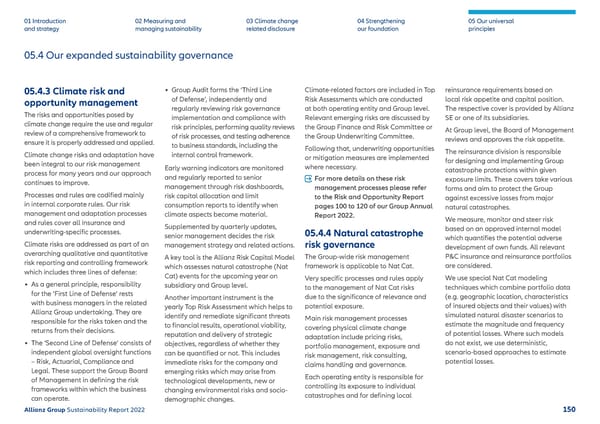01 Introduction and strategy 02 Measuring and managing sustainability 03 Climate change r elated disclosure 04 Strengthening our f oundation 05 Our universal principles 05.4 Our expanded sustainability governance 05.4.3 Climate risk and opportunity management The risks and opportunities posed by climate change require the use and regular review of a comprehensive framework to ensure it is properly addressed and applied. Climate change risks and adaptation have b een integral to our risk management process for many years and our approach continues to improve. Processes and rules are codified mainly in internal c orporate rules. Our risk management and adaptation processes and rules cover all insurance and underwriting-specific processes. Climate risks are addressed as part of an o verarching qualitative and quantitative risk reporting and controlling framework which includes three lines of defense: • As a general principle, responsibility for the ‘First Line of Defense’ rests with business managers in the related Allianz Group undertaking. They are responsible for the risks taken and the returns from their decisions. • The ‘Second Line of Defense’ consists of independent global oversight functions – Risk, Actuarial, Compliance and Legal. These support the Group Board of Management in defining the risk frameworks within which the business can operate. • Group Audit forms the ‘Third Line of Defense’, independently and regularly reviewing risk governance implementation and compliance with risk principles, performing quality reviews of risk processes, and testing adherence to business standards, including the internal control framework. Early warning indicators are monitored and r egularly reported to senior management through risk dashboards, risk capital allocation and limit consumption reports to identify when climate aspects become material. Supplemented by quarterly updates, senior management decides the risk management str ategy and related actions. A key tool is the Allianz Risk Capital Model which assesses natur al catastrophe (Nat Cat) events for the upcoming year on subsidiary and Group level. Another important instrument is the y early Top Risk Assessment which helps to identify and remediate significant threats to financial results, operational viability, reputation and delivery of strategic objectives, regardless of whether they can be quantified or not. This includes immediate risks for the company and emerging risks which may arise from technological developments, new or changing environmental risks and socio- demographic changes. Climate-related factors are included in Top Risk Assessments which ar e conducted at both operating entity and Group level. Relevant emerging risks are discussed by the Group Finance and Risk Committee or the Group Underwriting Committee. Following that, underwriting opportunities or mitigation measur es are implemented where necessary. [f) For more details on these risk management processes please refer to the Risk and Opportunity Report pages 100 to 120 of our Group Annual Report 2022. 05.4.4 Natural catastrophe risk governance The Group-wide risk management framework is applicable to Nat Cat. Very specific processes and rules apply to the management of Nat C at risks due to the significance of relevance and potential exposure. Main risk management processes c overing physical climate change adaptation include pricing risks, portfolio management, exposure and risk management, risk consulting, claims handling and governance. Each operating entity is responsible for c ontrolling its exposure to individual catastrophes and for defining local reinsurance requirements based on lo cal risk appetite and capital position. The r espective cover is provided by Allianz SE or one of its subsidiaries. At Group level, the Board of Management r eviews and approves the risk appetite. The reinsurance division is responsible f or designing and implementing Group catastrophe protections within given exposure limits. These covers take various forms and aim to protect the Group against excessive losses from major natural catastrophes. We measure, monitor and steer risk b ased on an approved internal model which quantifies the potential adverse development of own funds. All relevant P&C insurance and reinsurance portfolios are considered. We use special Nat Cat modeling techniques which c ombine portfolio data (e.g. geographic location, characteristics of insured objects and their values) with simulated natural disaster scenarios to estimate the magnitude and frequency of potential losses. Where such models do not exist, we use deterministic, scenario-based approaches to estimate potential losses. 150 Allianz Group Sustainability Report 2022
 Sustainability Report 2022 | Allianz Page 150 Page 152
Sustainability Report 2022 | Allianz Page 150 Page 152